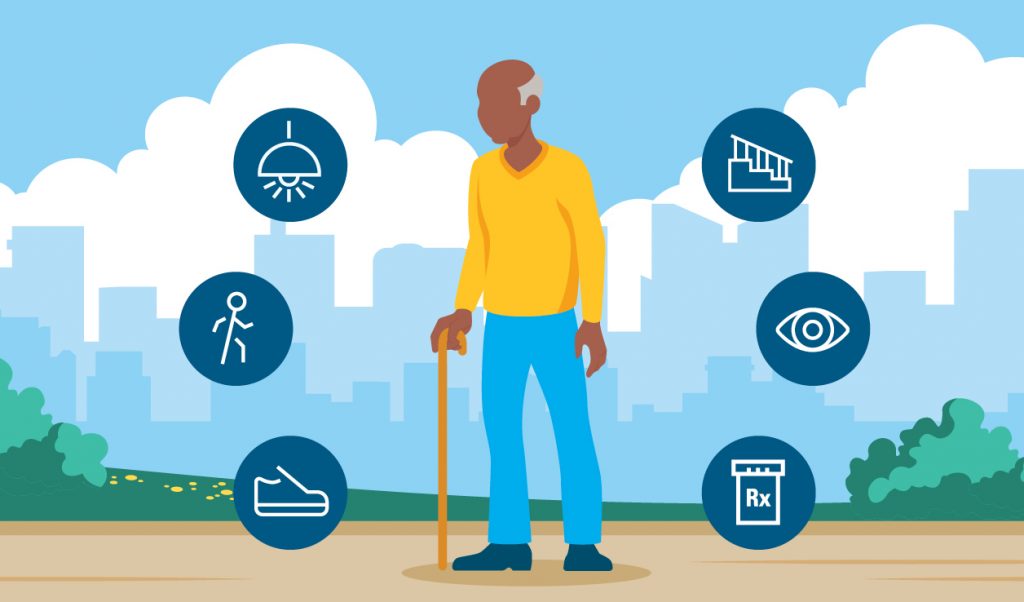Up until a few years ago, 61-year old Denise Gaard had never fallen. As a parish nurse at First Lutheran Church in St. Paul, an avid gardener and a daily walker, Gaard had always lived an active lifestyle.
When she fell and both fractured and dislocated her ankle, she needed months of rehab and her activity level drastically shifted. With that change came a blow to her independence and a new fear of falling — a normal, common response in older adults, but one Gaard had to overcome to get back to the things she loved.
“I hadn’t even thought about it before. I would work with people who were afraid of falling and I would help them,” Gaard says. “I didn’t really think about it for myself at all until after my fall.”
Recognizing and addressing that fear of falling, along with evaluating other risk factors and taking steps to minimize them, has put Gaard in a better, healthier place. Performing a fall-risk self assessment is a great idea for all older adults, along with proactive fall prevention. With the right steps, you can fend off falls.
Understanding risks Falls are the leading cause of injury among older adults in the U.S., according to the Centers for Disease Control and Prevention (CDC). But they are often preventable. The best way to prevent a fall is to understand what could lead to one.
Amy Dallmann, the program director for the Dancing Sky Area Agency on Aging (DSAAA), which serves older adults and communities in northwestern Minnesota, says falling is not a normal part of aging and it certainly is not inevitable. She says there are three main categories of risk factors:
Behavioral, such as placing items out of your reach or using alcohol.
Environmental, such as the type of house you’re living in or fixable factors, like removing rugs you could trip over.
Physical, which deals directly with your body, like loss of muscle strength, taking medications or impaired vision and hearing.
Here’s a closer look at common fall risk factors that you can use to evaluate your own risk level. This is not a comprehensive list, but one you can use to start thinking about your risk. Talk to your doctor about other potential risk factors.
- Fear of falling. This is a top predictor of a future fall.
- Not talking about your fear of falling with a loved one, doctor or caregiver. Hiding your fear can lead to increased anxiety and often results in limited movement and avoidance of activities, which worsens your risk of falling.
- Mobility limitations during your activities of daily living, such as dressing, showering or standing to prepare a meal.
- Impaired vision, hearing, gait or balance.
- Reduced muscle strength or poor reaction time.
- Taking medications that may cause side effects, such as drowsiness or dizziness. Using multiple medications also increases risk.
- Medical conditions such as diabetes, heart disease or problems with your thyroid, nerves, feet or blood vessels.
Practice prevention
Understanding your fall risk will help you find ways to prevent falls and maintain your independence. Let’s take a look at some ways that you can avoid falls in your own home and elsewhere.
- Stay physically active. Regular exercise, such as brisk walking 30 minutes a day and participating in balance and strength training, will help keep you strong and mobile. Exercise provides the greatest protection to reducing your risk of falling. SilverSneakers, a benefit included with your Blue Cross plan at no additional cost, is a good way to get started. Learn more at silversneakers.com.
- Talk to your pharmacist about potent i a l side effects from the medications you take. It’s a good idea to bring a list of your medications to your pharmacist for review at least once a year.
- Schedule and complete a vision exam at least once a year.
- Make items accessible. Remove things from high, hard-to-reach places and locate regularly used items on shelves or cabinets that are at waist to shoulder level.
- Install railings along both sides of stairways and handles in areas where you might be at higher risk for a fall, such as the bathroom.
- Remove clutter and get rid of tripping hazards, such as loose rugs and cords.
- Use assistive devices indoors and outdoors like a cane or walker.
- Talk to your doctor about durable medical equipment (DME).
- Make sure your home is well lit and install nightlights in hallways and bathrooms. When outside, walk in well-lit areas.
- Wear supportive footwear with good traction that is appropriate for the conditions and avoid shoes with heels.
- Avoid slippery surfaces.
- Avoid distractions while walking, such as using a cellphone.
- Get enough sleep.
- Limit the amount of alcohol you consume.
If you do experience a fall, it’s important to talk to your doctor about it, even if you don’t get hurt. Your doctor can work with you to reduce the risk of additional falls, performing a more thorough assessment of your health and medical conditions, medications, your style of walking, foot health, your balance, vision and more.


